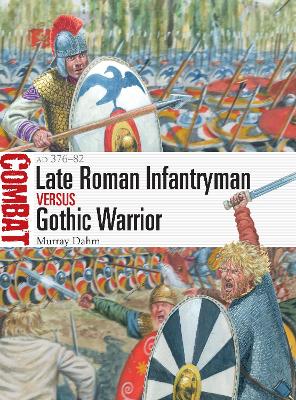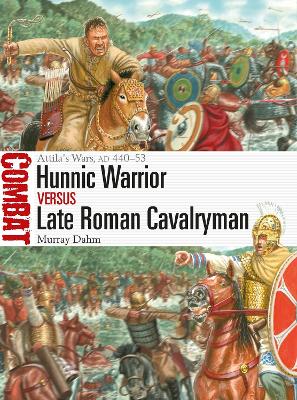Combat
2 total works
Ravaged by civil war and pressure from the Huns to the east, in late summer AD 376 the Gothic tribe of the Theruingi – up to 200,000 people under their leader Fritigern – gathered on the northern bank of the River Danube and asked the Eastern Roman emperor, Valens, for asylum within the empire. After agreeing to convert to Arian Christianity and enrol in the Roman Army, the Goths were allowed to cross the Danube and settle in the province of Thrace. Far more people crossed the Danube than the Romans expected, however, and with winter approaching, the local Roman commander, Lupicinus, lacked the resources to feed the newcomers and did not possess sufficient troops to control them. Treated poorly and running out of food, the Goths very quickly lost faith in the Roman promises.
Meanwhile, other Gothic tribes also sought permission to cross the Danube. The Greuthungi were refused permission, but soon learned that local Roman garrisons had been depleted to supervise the march of the Theruingi to the town of Marcianopolis, close to the eastern shore of the Black Sea. Taking advantage of this, the Greuthungi also entered Roman territory. Camping outside Marcianopolis, Lupicinus denied the Goths access to the town’s food stores, provoking the Theruingi to begin skirmishing with the Roman troops. Fritigern convinced Lupicinus to let the Gothic leaders go and calm their people, but they did nothing to quell the warlike temper of his warriors. Lupicinus summoned troops to him, but in late 376 these Roman forces were defeated – the first of several defeats for the Romans that would culminate in the fateful battle of Adrianople in August 378, at which Roman forces led by the emperor himself confronted the Gothic host. The aftermath and repercussions of Adrianople have been much debated, but historians agree that it marks a decisive moment in the history of the Roman world. This fully illustrated book investigates the fighting men of both sides who clashed at the battles of Marcianopolis, Ad Salices and Adrianople, as the fate of the Western Roman Empire hung in the balance.
Meanwhile, other Gothic tribes also sought permission to cross the Danube. The Greuthungi were refused permission, but soon learned that local Roman garrisons had been depleted to supervise the march of the Theruingi to the town of Marcianopolis, close to the eastern shore of the Black Sea. Taking advantage of this, the Greuthungi also entered Roman territory. Camping outside Marcianopolis, Lupicinus denied the Goths access to the town’s food stores, provoking the Theruingi to begin skirmishing with the Roman troops. Fritigern convinced Lupicinus to let the Gothic leaders go and calm their people, but they did nothing to quell the warlike temper of his warriors. Lupicinus summoned troops to him, but in late 376 these Roman forces were defeated – the first of several defeats for the Romans that would culminate in the fateful battle of Adrianople in August 378, at which Roman forces led by the emperor himself confronted the Gothic host. The aftermath and repercussions of Adrianople have been much debated, but historians agree that it marks a decisive moment in the history of the Roman world. This fully illustrated book investigates the fighting men of both sides who clashed at the battles of Marcianopolis, Ad Salices and Adrianople, as the fate of the Western Roman Empire hung in the balance.
Roman and Hunnic fighting men are assessed and compared in this fully illustrated study of Attila's bid to conquer Europe in the 5th century AD.
The Huns burst on to the page of western European history in the 4th century AD. Fighting mostly on horseback, the Huns employed sophisticated tactics that harnessed the formidable power of their bows; they also gained a reputation for their fighting prowess at close quarters. Facing the Huns, the Roman Army fielded a variety of cavalry types, from heavily armed and armoured clibanarii and cataphractii to horse archers and missile cavalry. Many of these troops were recruited from client peoples or cultures, including the Huns themselves.
After carving out a polyglot empire in eastern and central Europe, the Huns repeatedly invaded Roman territory, besieging the city of Naissus in 443. With Constantinople itself threatened, the Romans agreed to pay a huge indemnity. In 447, Attila re-entered Roman territory, confronting the Romans at the battle of the Utus in Bulgaria. The Huns besieged Constantinople, but were unable to take the city. In 451, after Hunnic forces invaded the Western Roman Empire, an army led by the Roman general Aetius pursed the invaders, bringing the Huns to battle at the Catalaunian Plains.
Featuring specially commissioned artwork and maps, this study examines the origins, fighting methods and reputation of the two sides' cavalry forces, with particular reference to the siege of Naissus, the battle of the Utus and the climactic encounter at the Catalaunian Plains.
The Huns burst on to the page of western European history in the 4th century AD. Fighting mostly on horseback, the Huns employed sophisticated tactics that harnessed the formidable power of their bows; they also gained a reputation for their fighting prowess at close quarters. Facing the Huns, the Roman Army fielded a variety of cavalry types, from heavily armed and armoured clibanarii and cataphractii to horse archers and missile cavalry. Many of these troops were recruited from client peoples or cultures, including the Huns themselves.
After carving out a polyglot empire in eastern and central Europe, the Huns repeatedly invaded Roman territory, besieging the city of Naissus in 443. With Constantinople itself threatened, the Romans agreed to pay a huge indemnity. In 447, Attila re-entered Roman territory, confronting the Romans at the battle of the Utus in Bulgaria. The Huns besieged Constantinople, but were unable to take the city. In 451, after Hunnic forces invaded the Western Roman Empire, an army led by the Roman general Aetius pursed the invaders, bringing the Huns to battle at the Catalaunian Plains.
Featuring specially commissioned artwork and maps, this study examines the origins, fighting methods and reputation of the two sides' cavalry forces, with particular reference to the siege of Naissus, the battle of the Utus and the climactic encounter at the Catalaunian Plains.

